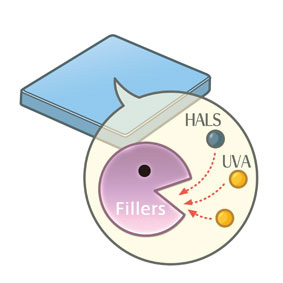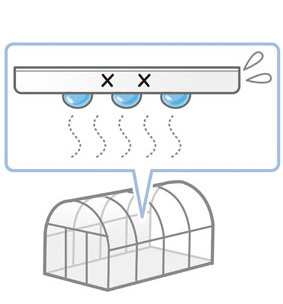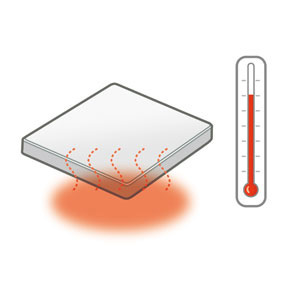Common Problems and Selection of Additives
Common problems during molding and production processes and the corrective measures are explained below. Please refer to the information below when selecting additives.
Frequently Asked Questions
- Influence of
Additives
during Molding - Extension of
Heat Stability - Extension of
Weathering Stability - Discoloration
- Impairment of
Design Aesthetics
-
Extension of Weathering Stability
Q6
When fillers and pigments are blended into plastic, how do they affect weatherability? (What is the difference from formulations with no pigment or talc?)
A6
 Prevention of accelerated degradationThe weathering performance of plastics containing fillers or pigments differ from that without them. Fillers or pigments impair weatherability, and this is presumed to be due to fillers adsorbing additives such as light stabilizers.
Prevention of accelerated degradationThe weathering performance of plastics containing fillers or pigments differ from that without them. Fillers or pigments impair weatherability, and this is presumed to be due to fillers adsorbing additives such as light stabilizers.
Corrective Measures
- 1
-
Use HALS which are less prone to being adsorbed by fillers.
Due to the increased surface temperature caused by absorption of thermal radiation, plastic with pigment may undergo not only light degradation but also thermo-oxidative degradation. Consideration of heat stability is therefore necessary.
- 2
- Use a HALS with strong oxidation preventing capabilities (ADK STAB LA-52 or LA-72).
- 3
-

Select a HALS with optimum molecular weight, since additives migrate faster as surface temperature increases. For example, for plastic with pigment, it is desirable to use a HALS with a molecular weight of approximately 600 to 1,000 (ADK STAB LA-52, etc.)
Q7
How to prevent performance deterioration when using agricultural chemicals, etc.
A7
Substances such as agricultural chemicals and the curing catalysts in paints contain acidic substances, which often lower the weatherability of plastic. For example, in agricultural greenhouse application, even if the polyolefin films contain HALS, it may have almost no effect due to the influence of agricultural chemicals, etc. In addition, thioether antioxidants, which are added in order to prevent thermo-oxidative degradation, may produce an acidic substance, so that when they are used in combination with a HALS, its performance might be lower than expected. Careful attention therefore needs to be paid to these issues.
Corrective Measures
- 1
- Use a HALS with lower basicity (ADK STAB LA-81), which is not susceptible to the effect of acidic substances.
Q8
How does temperature affect plastics during their use?
A8
 Under high temperature contidion, thermo-oxidative degradation proceeds more readily. Especially, when pigments are used, thermal oxidation is the main reason of the degradation. In addition, in applications in which plastics are used at high temperatures, although thioether antioxidants are sometimes used in combination with HALS, they may reduce the effect of the latter, which are added in order to improve weatherability. Careful attention therefore needs to be paid to these issues.
Under high temperature contidion, thermo-oxidative degradation proceeds more readily. Especially, when pigments are used, thermal oxidation is the main reason of the degradation. In addition, in applications in which plastics are used at high temperatures, although thioether antioxidants are sometimes used in combination with HALS, they may reduce the effect of the latter, which are added in order to improve weatherability. Careful attention therefore needs to be paid to these issues.
Corrective Measures
- 1
- For applications in which plastics are used at high temperatures, select a HALS that has strong capabilities with regard to preventing thermo-oxidative degradation (ADK STAB LA-52 or LA-63P, etc.), paying careful attention to the fogging and migration properties of these additives.
- 2
- For applications in which plastics are used at high temperatures and need to exhibit photostability, thioether antioxidants should be used. They are effective when used in combination with a weakly basic HALS (ADK STAB LA-81 etc.).
